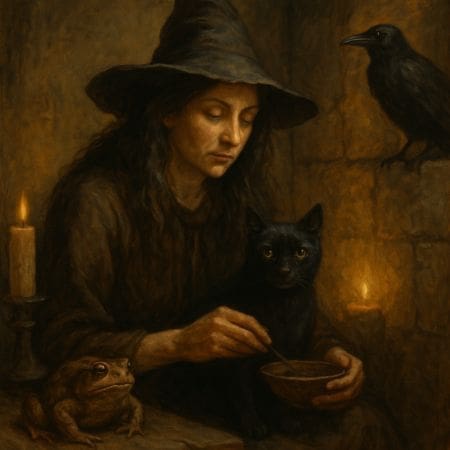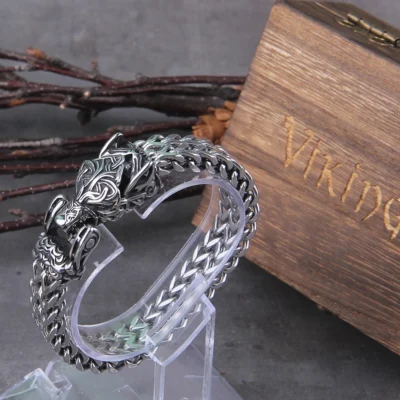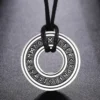Shadows at a Witch’s Heel
Picture a flickering candle, the scent of tallow thick in the air. A lone woman mutters spells over herbs, her black cat watching with unblinking green eyes. It’s an image that has seeped into our culture — the witch and her familiar.
Yet the story of the witch’s familiar stretches far deeper than popular Halloween tropes. Rooted in medieval history and folklore, these mysterious animals were once feared as demonic imps and presented as damning evidence in witch trials. Today, however, familiars are cherished symbols in modern witchcraft, revered as partners in magic and guardians of the spirit.
In this article, we’ll wander through the shadowy corridors of history to discover how the familiar evolved from a sinister sign of witchcraft into a beloved magical companion.

Folklore’s Creatures: The Birth of the Familiar
In medieval Europe, people lived side by side with animals, from working dogs and cats that kept vermin at bay to barn owls shrieking over fields. But in an age steeped in superstition, not all creatures were merely animals. Some were thought to possess supernatural powers, acting as spies or helpers for witches.
A Pact with the Devil?
Church authorities believed witches entered into pacts with the Devil, who gifted them a familiar — an imp or demon taking the form of an animal. These creatures were said to suckle on the witch’s body, feeding on blood in exchange for magical aid.
Tales spoke of cats, toads, ferrets, dogs, ravens, weasels, and even insects becoming familiars. These animals supposedly whispered secrets, fetched hidden knowledge, or carried out curses upon command. Their uncanny loyalty and inexplicable intelligence only deepened suspicions.
Familiars in Witch Trials: Evidence of Evil
As witchcraft hysteria swept Europe between the 15th and 17th centuries, the notion of the familiar played a pivotal role in trials.
“Teats” and Telltale Marks
During interrogations, witch-hunters searched for the “witch’s mark” — a mole, blemish, or extra nipple believed to be a feeding spot for the familiar. If such a mark was found, it was used as evidence of a witch’s unholy alliance.
Court records from England and Wales abound with references to familiars:
- In 1645, the notorious Witchfinder General, Matthew Hopkins, documented witches in Essex who confessed their familiars’ names — Vinegar Tom (a greyhound with an ox’s head), Pyewacket (shape unknown), and Sacke and Sugar (a rabbit-like creature).
- During the Pendle Witch trials of 1612, Alizon Device claimed that a black dog appeared to her, asking her soul in exchange for power.
Such testimonies might sound bizarre, but they were often extracted under extreme duress or torture. The mere presence of a pet could doom someone to the gallows.
Cats, Toads and Birds: Creatures of Magic and Misfortune
Of all animals accused of being witches’ allies, cats bore the greatest burden.
The Black Cat’s Curse
In medieval times, black cats were admired for their hunting prowess yet feared for their nocturnal habits and eerie gaze. The Church, eager to stamp out pagan remnants, declared cats as instruments of Satan. Pope Gregory IX’s decree in the 1230s ignited mass killings of cats, a move some historians speculate worsened the spread of the Black Death by leaving rodent populations unchecked.
Toads were equally vilified. Slippery, poisonous, and secretive, they seemed perfect candidates for dark magic. Tales flourished of witches milking toads for venom or transforming them into deadly talismans.
Birds, too, bore suspicion. Ravens and owls were believed to carry messages between witches and spirits, their cries considered omens of death.

The Familiar in Modern Witchcraft: A Loving Ally
Fast-forward to today, and the witch’s familiar has undergone a remarkable transformation.
In modern witchcraft — from Wicca to eclectic pagan paths — a familiar is viewed not as a demon but as a spiritual partner. Many witches speak of a living pet — often a cat, dog, or bird — who shares their magical space, offering comfort and grounding energy.
However, not all familiars are flesh and blood. Some practitioners connect with animal spirits during meditation, envisioning a wolf, snake, fox, or owl guiding them through spiritual work. These spirits become guardians, protectors, or messengers, offering insights into life’s mysteries.
Sacred Companionship
Modern witches honour their familiars with rituals and offerings. A cat might curl on the altar, absorbing energies. A dog might sit beside their human during spellwork, radiating loyalty and calm. Even wild animals glimpsed repeatedly in dreams or nature can be seen as signs of a spirit familiar making contact.
Far from being sinister, familiars today represent:
- Intuition and psychic awareness
- A bridge between physical and spiritual realms
- Loyalty and emotional support
- Protection against negative energies
The Enduring Legacy of Familiars
From the dark corners of medieval courtrooms to the gentle purring of a cat in a modern witch’s living room, the story of the witch’s familiar reminds us how powerfully humans project meaning onto the animals that share our world.
They were once feared as imps of the Devil, condemned alongside their human companions. Today, they stand as symbols of magic, wisdom, and profound connection — living proof that even the darkest superstition can transform into beauty over time.
So next time your cat stares at a spot unseen, or a raven calls from the treetops, perhaps consider — in the dance of shadow and light, the world of the familiar might still be closer than we think.
Want More Tales of Witchcraft and Medieval Mysteries?
Explore our other articles on Witch Marks and Protective Symbols or delve into the secrets of Medieval Magic and Alchemy for a journey through history’s most spellbinding tales.
Explore our Medieval Halloween guide

Medieval Magic
From enchanted pendants to legendary relics, this collection channels the magic, myth, and symbolism of the Middle Ages.
Whether you seek protection, wisdom, or just a touch of otherworldly style — you’ll find your talisman here.







